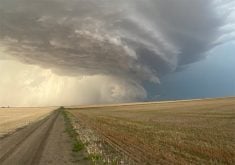DUBLIN, Ireland – The practice of selling horses to children as pets is keeping the Dublin Society for the prevention of Cruelty to Animals busy.
Sean Gibney, a DSPCA inspector, said the horses are bought in Ireland and England for about $30 and sold to children in the Irish capital for $80 to $100.
The children are often from poor or underprivileged families and the horses are often not in the best of health.
“A lot of the time, they have been young colts, yearlings, unbridled. They give them to the kids for $80 at the fair and the kids walk them home,” Gibney said.
Read Also

Rented farmland jumps 3.4 million acres in Saskatchewan and Alberta
Farmland rented or leased in the two provinces went from 25.7 million acres in 2011 to 29.1 million in 2021, says Census of Agriculture data.
The horses are often kept in grassy areas of Dublin known as commonage – parks, along rivers, and landfill areas.
The children often can’t afford the horses’ keep and don’t know anything about maintaining horses. Abuse is common.
“Kids don’t have money to look after it (the horse), they abandon it and we’re called in,” Gibney said.
Phil O’Malley-Cooley from the DSPCA said the children often exhaust the horses by riding them too much.
“You have to tell them these animals aren’t made to ride all day, back and forth.”
Gibney said the law allows inspectors to step in under certain conditions.
It is illegal to sell a horse to someone younger than 16 unless the child is accompanied by a parent. Inspectors can confiscate horses if they are injured or abused.
Some people have argued that the horse sales should be allowed because they keep kids out of trouble and off drugs.
Gibney disagrees.
“That’s a myth,” he said.
“If the kid wants, the kid will take drugs. It doesn’t matter whether the kid has a horse or not.”
Gibney said inspectors are not out to seize horses, “but if the pony is ill, or ill-treaten, or malnourished, or suffers injury because it was galloped around by the kids, then we step in.”
In one case, inspectors stayed away from a landfill where 50 to 60 horses roam, until they knew one of the horses had a broken leg. The horse was removed.
Gibney said a load of 20 horses was recently confiscated from an angry owner. The load had made it through the British port and only was questioned when it reached Ireland. Some of the horses had equine flu or were underweight.
In another case, inspectors were called after a four-year-old horse was caught in security fencing, its back legs severely lacerated. Seven weeks later, it is still recovering in a DSPCA facility.
In another example, Gibney was called to a commonage area where he found 45 horses, 10 of which were yearlings. Three were dead, two were lying alive on the ground but had to be shot. The rest were in such poor health that it took six months for them to recover under DSPCA care.














